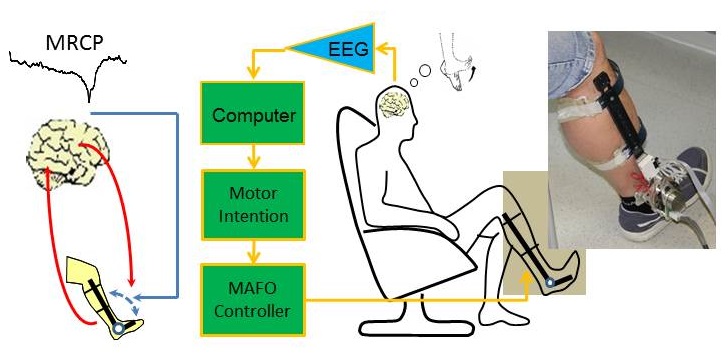Ren Xu, Ning Jiang, Natalie Mrachacz-Kersting, Chuang Lin, Guillermo Asín Prieto, Juan C. Moreno, Jose L. Pons, Kim Dremstrup, and Dario Farina, University Medical Center Göttingen, Georg-August University, Dalian University of Technology, Aalborg University, and Consejo Superior de Investigaciones Científicas
Volume 61, Issue 7, Page:2092-2101

Recently, brain-computer interfacing (BCI) systems have been applied as potential rehabilitation tools for neurological disorders, such as stroke. In these applications, BCI is used to detect motor intentions of the user during motor imagination in order to activate an external device, such as electrical stimulation, or visual feedback. This general approach is thought tore-establish the closed-loop sensory-motor interaction and facilitate positive plasticity of the central nervous system. Movement-related cortical potentials (MRCP), a type of slow cortical potential obtained from scalp EEG, provide an accurate means for detecting the motor intention with very short delay. This characteristics can be exploited for providing artificial sensory feedback in concomitance with the motor command of the user, in order to mimic the natural association between motor commands and the associated sensory feedback. Despite these concepts are logical, their neurophysiological bases are currently not strongly proven. Therefore, in this study we verify the hypothesis that Hebbian plasticity occurs when, and when, artificial afferents is delivered in synchrony with the movement intention of the user, detected by a BCI system. For this purpose, we activated a Motorized Ankle-Foot Orthosis (MAFO), which is designed specifically for ambulatory rehabilitation of drop-foot. MAFO is driven by a novel BCI system that is able to detect motor intention from MRCPs online, with a few hundreds milliseconds of delay. In a completely online and asynchronous BCI-MAFO paradigm with healthy subjects, we proved that cortical excitability, as measured by transcranial magnetic stimulation, increased significantly immediately following and 30 min after the BCI-MAFO intervention, which is only ~15 min long. Such change is shown not to occur in a number of control conditions. The proposed system provides a fast and effective approach for inducing cortical plasticity through BCI, and has potential in motor function rehabilitation following stroke. Moreover, the study constitutes a strong neurophysiological basis for the use of BCI for neuromodulation.
Keywords: Brain-computer interfacing, Motorized Ankle-Foot Orthosis, movement-related cortical potential, plasticity, stroke rehabilitation

